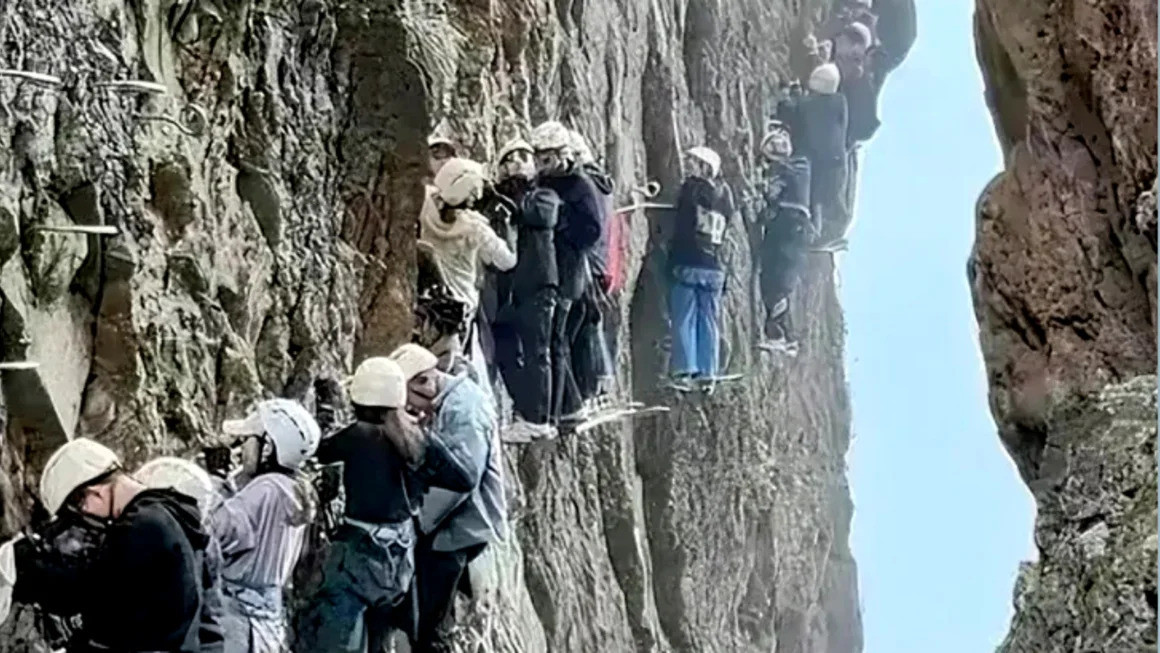
Earlier this week, groups of tourists climbing the Wudang Mountains in eastern China were stranded for hours on steep cliffs, many clinging to safety ropes strung along the climbing route.
“This is so scary! Someone like me who is afraid of heights might faint up there!” one social media user commented.
“Even if you paid me, I wouldn’t dare go to Wudang to climb the mountain again,” said another. Meanwhile, some people wondered what would happen if a tourist couldn’t bear it and fell.
Wenzhou Dingqing Sports Development Co., Ltd. quickly dismissed the idea, insisting that all tourists were provided with helmets, harnesses, and other safety equipment. The company also admitted that it had “mispredicted the number of people who would come to climb Wudang Mountain during this holiday.”
“Due to a misjudgment of the number of visitors during the Labor Day holiday, our management has shown weaknesses in not taking measures to control the number of climbers at the same time. We are sorry that customers were stuck and unable to move while climbing,” said a company representative.
The company added that it is temporarily suspending ticket sales to tourists to climb the mountain in order to rebuild the climbing process and route to ensure safety for tourists. In the future, the company will deploy a system to control the number of people going up and down Yandang Mountain at the same time.
In China, workers will have a day off for International Workers' Day in the first week of May. This contributes to an increase in tourist arrivals to popular destinations.
China's Ministry of Culture and Tourism said 295 million tourists visited China during the May Day holiday, up 28% from the same period in 2019 and generating $23.6 billion in tourism revenue over the five days.
Wudang Mountain is located in eastern China, about 410 km south of Shanghai. It is in Zhejiang province and has an altitude of 1,150 m.
As a famous landmark in China, Wudang Mountain was recognized by UNESCO as a World Heritage Site in 2001 and attracts millions of visitors every year.
Source


![[Photo] Hanoi morning of October 1: Prolonged flooding, people wade to work](https://vphoto.vietnam.vn/thumb/1200x675/vietnam/resource/IMAGE/2025/10/1/189be28938e3493fa26b2938efa2059e)






















![[Photo] President Luong Cuong receives President of the Cuban National Assembly Esteban Lazo Hernandez](https://vphoto.vietnam.vn/thumb/1200x675/vietnam/resource/IMAGE/2025/9/30/4d38932911c24f6ea1936252bd5427fa)
![[Photo] The 1st Congress of Phu Tho Provincial Party Committee, term 2025-2030](https://vphoto.vietnam.vn/thumb/1200x675/vietnam/resource/IMAGE/2025/9/30/1507da06216649bba8a1ce6251816820)
![[Photo] Panorama of the cable-stayed bridge, the final bottleneck of the Ben Luc-Long Thanh expressway](https://vphoto.vietnam.vn/thumb/1200x675/vietnam/resource/IMAGE/2025/9/30/391fdf21025541d6b2f092e49a17243f)










































![[Megastory] A term of creation: An Giang rises from historical imprints](https://vphoto.vietnam.vn/thumb/402x226/vietnam/resource/IMAGE/2025/10/1/2660ab96e53f4270bcc37f8d39c36c78)



















Comment (0)